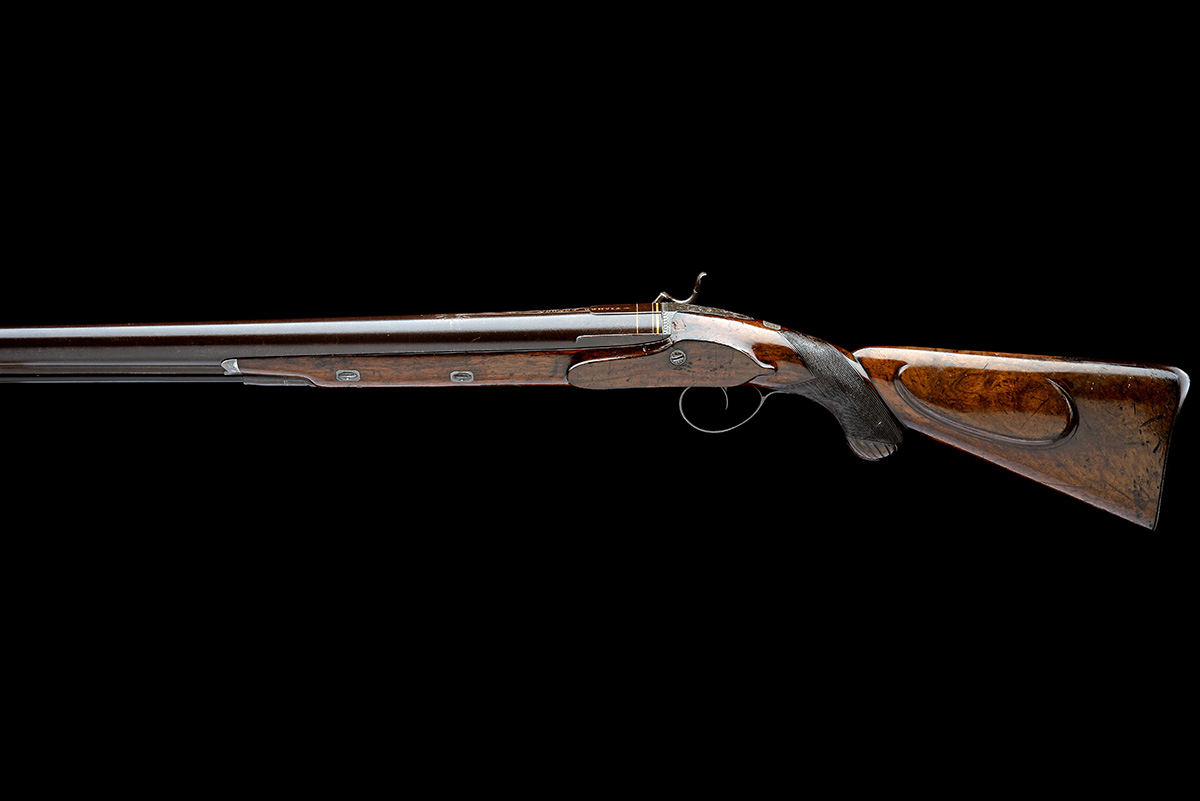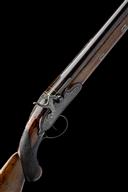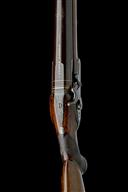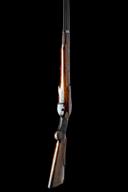Product Details
A SUBSTANTIAL 6-BORE PERCUSSION FOWLING PIECE SIGNED FISHER, LONDON, no visible serial number,
circa 1800, originally a flintlock and with subsequent conversions to pill and finally cap-lock, with fine strongly tapering round 41in. browned barrel with silver bead fore-sight and short sighting flat at breech signed in gilt 'FISHER, LONDON', the signature extending along and engraved needle terminating in a starburst, further gilt bands at breech together with an engraved band, fully engraved top-tang, bevel-edged lock with stepped and engraved pointed tail and signed below the original pan cut-out 'FISHER', bulbous drum and nipple, engraved slab-sided hammer with detachable 'pill-lock' nose, heavy walnut half-stock with chequered semi pistol-grip, gadrooned pommel, raised cheek-piece, iron furniture except clipped corner rectangular white metal escutcheon at wrist and for the barrel key and white metal fore-end cap, substantial brass-mounted ebony ramrod, weight approximately 16 1/2lb.
Provenance: This gun was formerly the property of John Nigel George 1903-1942.
It features on pages 262-3 and plate XVIII figure 1 of his book 'English Guns & Rifles'. Though listed as a 4-bore "Of this plug conversion a good example may be seen in Figure (1) of Plate XVIII in which is shown the lock of a fine 4-bore duck gun, made by Fisher, of No. 203 High Holborn, and of the period shortly after 1800, which has apparently been converted to percussion some twenty years later. Both the form and engraving of its new hammer are strongly reminiscent of those of the hammers found upon the Forsyth and Richards locks of the 1820 period and the fact of its being fitted with a detachable "striker", which can be replaced as it becomes worn, also marks it as belonging to the first few years of the percussion cap era".
The aforementioned book was intended to be a companion volume to his earlier work, 'English Pistols and Revolvers." He wrote the first 11 chapters and made the headings and notes for the 12th chapter. He drew all the line drawings and illustrations and planned photographic illustrations.
In March 1939, George joined the 5th Royal West Kent Regiment of the British Volunteer Territorial Army and was, therefore, ready when the Territorial Army was merged in the British Army upon war being declared upon Germany by Great Britain September 3rd, 1939.
It was agreed to delay the publication of the book until hostilities were ended, and that should George no survive the war, one of his many friends Mr S.B. Haw, should write chaper 12 and draw up a bibliography and an index.
George lived through Dunkirk and recovered from a severe head wound he had received during the Belgian Flanders campaign. He served for a period in England, and following strenuous training, went to Egypt with the 8th Army. On the long journey from the Cape he wrote of new friends and interests. Following an action in North Africa on September 3rdm 1942, he was killed by an enemy sniper.
Please click HERE to view Terms & Conditions. Please note all Lots are listed in accordance with UK Law, for overseas buyers, please ensure you are familiar with your relevant local firearms and customs regulations before bidding.
Estimate £2,000-3,000









